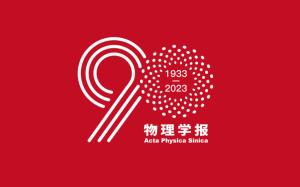
The 90th Anniversary ofActa Physica Sinica
EDITOR'S SUGGESTION
2023, 72 (23): 230103.
doi:10.7498/aps.72.20231851
Abstract +
Acta Physica Sinica(Chinese version) resumed its publication in January 1974, after an unplanned suspension of publication for seven and half years. This paper presents some reminiscences about this event, including some background stories as well as the hard and passionate work of elderly generations of Chinese physicists.
EDITOR'S SUGGESTION
2023, 72 (23): 230104.
doi:10.7498/aps.72.20231739
Abstract +
My scientific career has been closely associated withActa Physica Sinica, receiving from her forceful support at crucial moments, with deep gratitude. My maiden work opening up independent exploration is still widely cited in frontier research after 60 years; the up-to-date frontier calculations, surviving disruptions and isolation during the “cultural revolution” have laid down the ground for the international scientific exchange after reforms and opening up.

EDITOR'S SUGGESTION
2023, 72 (23): 230302.
doi:10.7498/aps.72.20231128
Abstract +
Ion trap is one of the leading physical platforms to implement quantum computation. Currently, high-fidelity elementary quantum operations above the fault-tolerant threshold, including state preparation, measurement and universal gates, have been demonstrated for tens of ionic qubits. One important future research direction is to further enlarge the qubit number to the scale required for solving practical problems while maintaining the high performance of individual qubits. This paper introduces the current mainstream schemes for scalable ion trap quantum computation like quantum charge-coupled device (QCCD) and ion-photon quantum network, and describes the main limiting factors in current research. Then we further explore new schemes to scale up the qubit number like two-dimensional ion crystals and dual-type qubit, and discuss the future research directions.
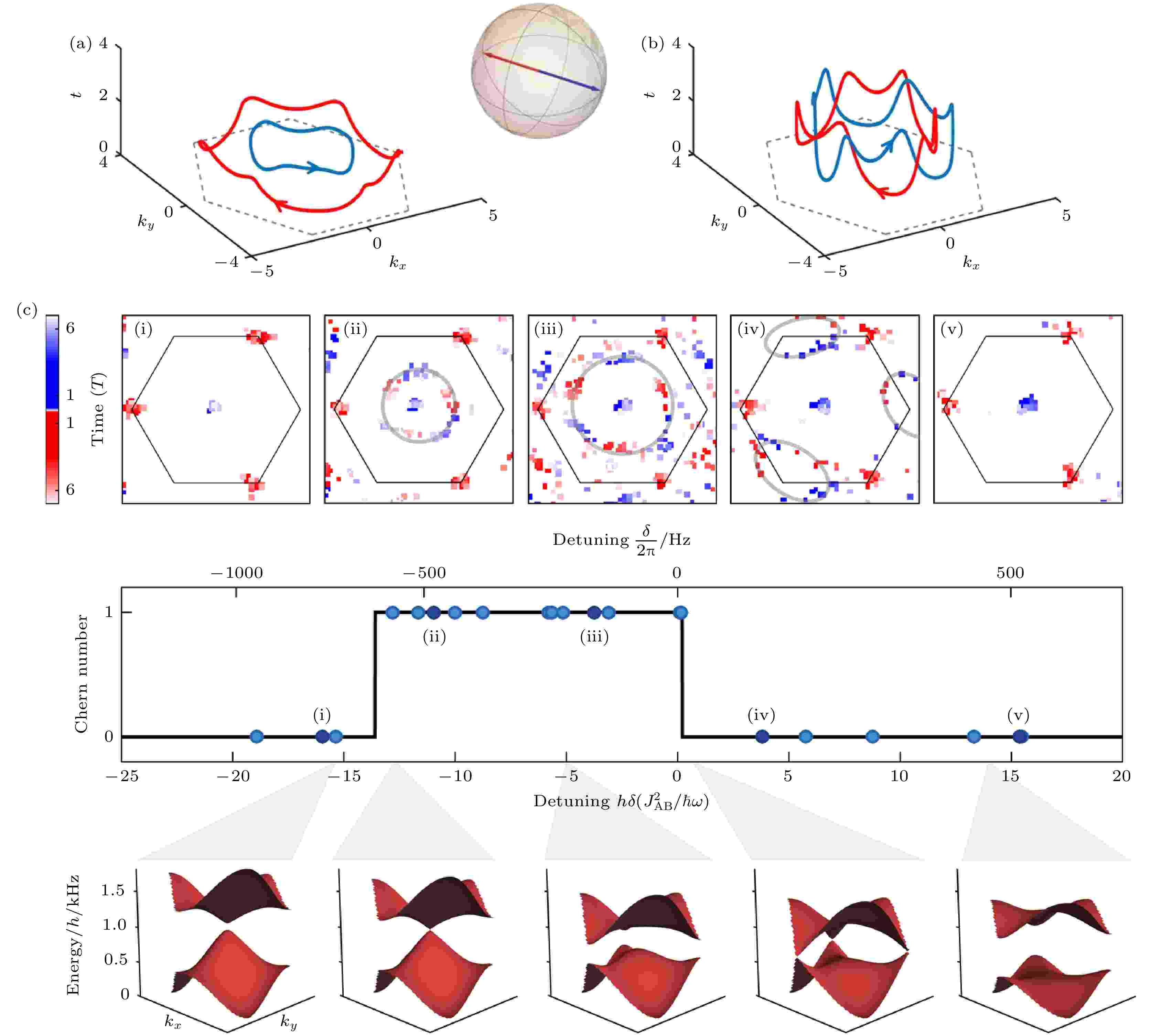
VIEWS AND PERSPECTIVES
2023, 72 (23): 230701.
doi:10.7498/aps.72.20231375
Abstract +
Combining quantum many-body physics and nonequilibrium physics is an important opportunity and challenge for current physics research. Nonequilibrium quantum many-body physics is not only a subject of common interest to many branches of physics but also an indispensable theoretical foundation for developing emergent quantum technologies. Cold atom system provides an ideal platform for studying nonequilibrium quantum many-body physics. The advantages of cold atom system, as well as other synthetic quantum systems, are reflected in studying various nonequilibrium processes such as the thermalization of isolated system, dissipation induced by coupling to the environment, ramping, quench, or periodically driving physical parameters of a system. In this work, three examples from our research are discussed to show how the study of nonequilibrium quantum many-body physics with cold atoms can help us go beyond the existing framework of topological physics, uncover new methods of detecting quantum many-body correlations, and enrich the physical content of gauge theory. Such a research concerns the fundamental properties of quantum many-body system, such as topology and correlation, utilizes the advantages of cold atomic system to achieve a quantitative comparison between theory and experiment, and aims at discovering universal physical rules for nonequilibrium quantum many-body process, which can be extended to condensed matter and nuclear matter systems.

VIEWS AND PERSPECTIVES
2023, 72 (23): 234201.
doi:10.7498/aps.72.20231295
Abstract +
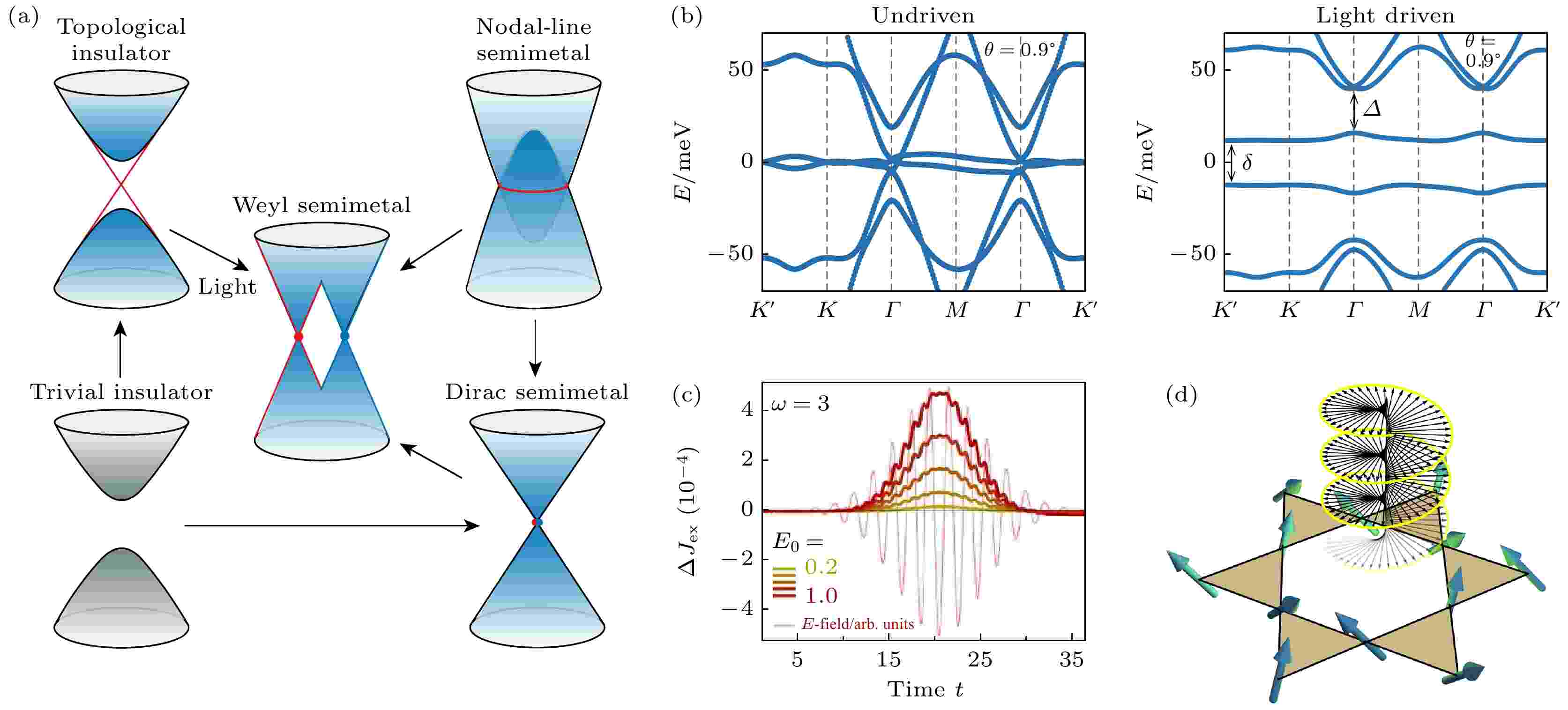
VIEWS AND PERSPECTIVES
2023, 72 (23): 234202.
doi:10.7498/aps.72.20231423
Abstract +
Floquet engineering based on the strong light-matter interaction is expected to drive quantum materials into nonequilibrium states on an ultrafast timescale, thereby engineering their electronic structure and physical properties, and achieving novel physical effects which have no counterpart in equilibrium states. In recent years, Floquet engineering has attracted a lot of research interest, and there have been numerous rich theoretical predictions. In addition, important experimental research progress has also been made in several representative materials such as topological insulators, graphene, and black phosphorus. Herein, we briefly introduce the important theoretical and experimental progress in this field, and prospect the research future, experimental challenges, and development directions.
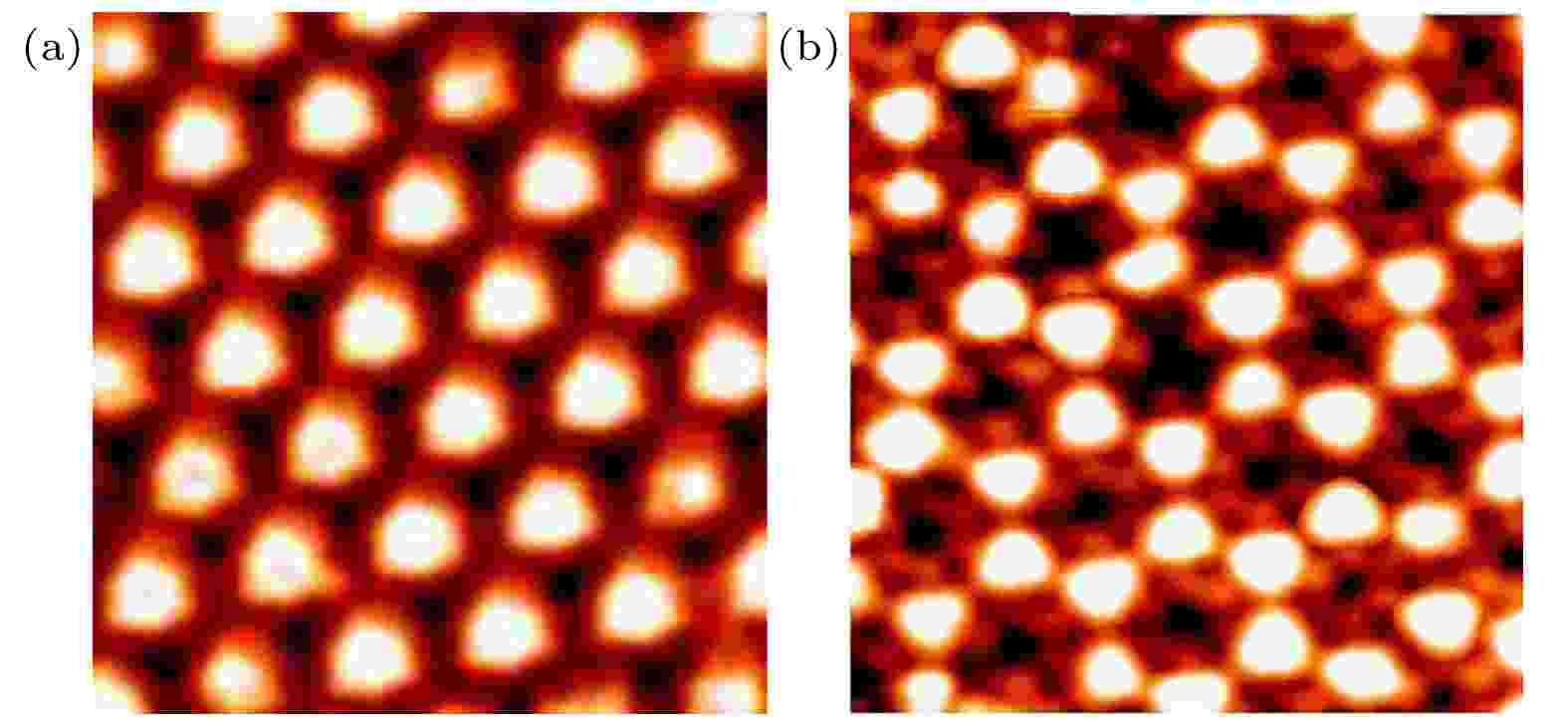
EDITOR'S SUGGESTION
2023, 72 (23): 236801.
doi:10.7498/aps.72.20231858
Abstract +
In this paper, the development of surface physics in China is comprehensively reviewed, focusing on the State Key Laboratory of Surface Physics at the Chinese Academy of Sciences. It especially recognizes and honors the invaluable contributions made by the older generation of scientists in this field. By looking back at the history, it can be seen that the surface physics has developed vigorously in China: not only have many research papers with international advanced level been published, but also a large number of young talents have been cultivated, who have become an important force in the research of condensed matter physics internationally.

VIEWS AND PERSPECTIVES
2023, 72 (23): 237101.
doi:10.7498/aps.72.20231508
Abstract +

VIEWS AND PERSPECTIVES
2023, 72 (23): 237302.
doi:10.7498/aps.72.20231323
Abstract +
In van der Waals system, the interlayer van der Waals coupling between adjacent atomically thin layers makes the electronic wave function spread on more than one specific layer, turning spatial discrete layer degree of freedom into a quantum mechanical degree of freedom. The coupling of layer degree of freedom with the in-plane center-of-mass motion of electrons forms a nontrivial layer pseudospin structure in momentum space, resulting in various new quantum geometric properties in an extended parameter space, which is unique to the lattice mismatched van der Waals systems. They trigger off a plenty of novel transport and optical effects, linear and nonlinear responses, and offer new pathways towards device applications, becoming the research frontiers of quantum layertronics. This article briefly reviews this emerging research direction, and discusses possible development in the near future based on its crossing with other intensive research fields such as nonlinear electronics, twistronics and chiral electronics.
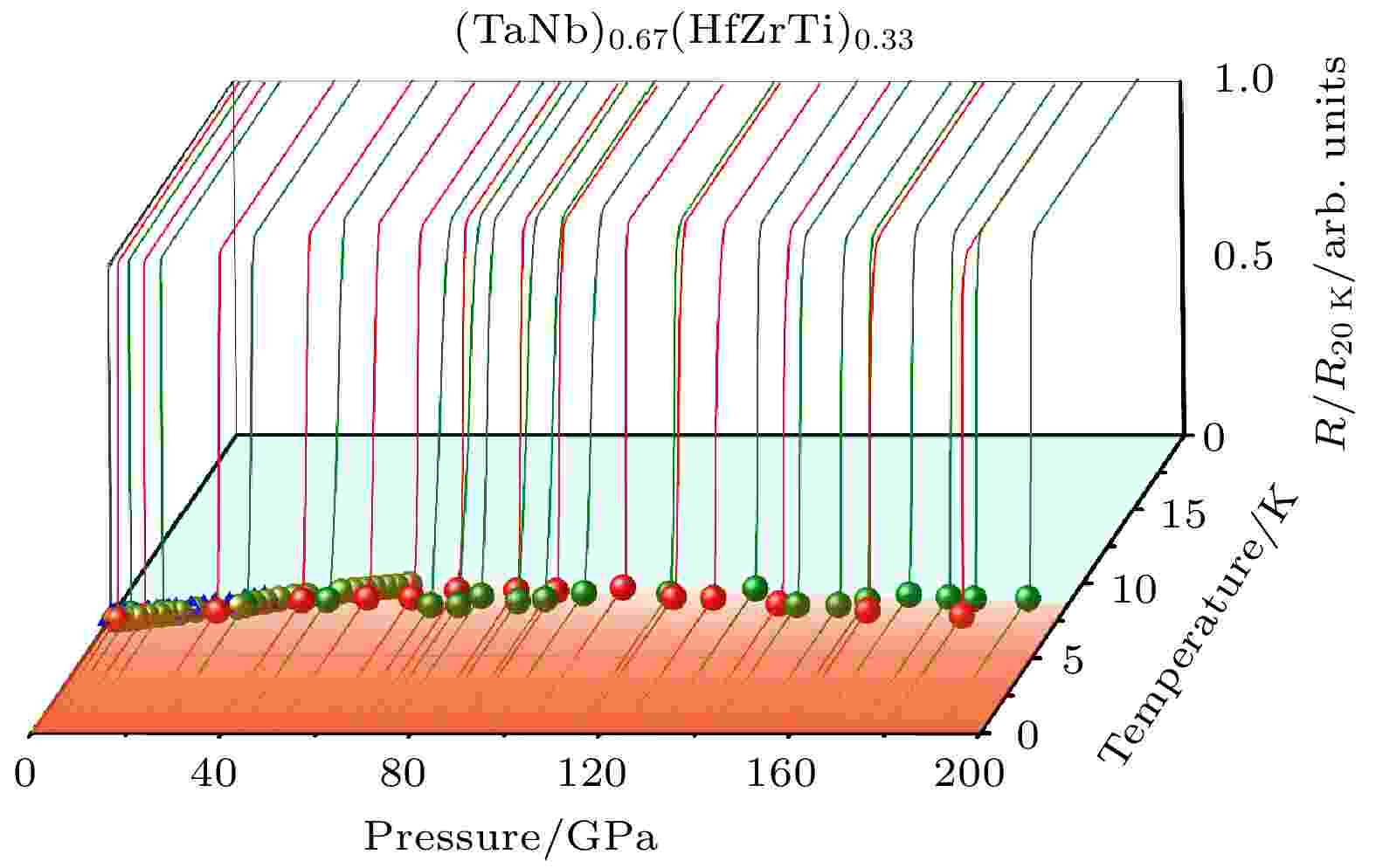
EDITOR'S SUGGESTION
2023, 72 (23): 237401.
doi:10.7498/aps.72.20231341
Abstract +
The superconducting transition temperature (Tc) of superconductor is related intimately to multiple degree of freedom of charge, spin, orbital and lattice. Many studies have indicated that pressure is an effective way to tuneTcthough changing crystal structure and electronic structure. Here, we report a new progress made in the high-pressure studies – discovery of a new type of superconductors whoseTcis robust against large volume shrinkage under extremely high pressure, named RSAVS (robust superconductivity against volume shrinkage) superconductor. Such RSAVS behavior was observed initially in the high entropy alloys of (TaNb)0.67(HfZrTi)0.33and (ScZrNbTa)0.6(RhPd)0.4, then in the widely-used NbTi alloy, Nb and Ta elements. Analysis shows that this type of superconductor possesses a body-centered cubic crystal structure and is composed of transition metal elements. The observed results not only present new research topics but also raise the question of what determinesTcof conventional or unconventional superconductors.

EDITOR'S SUGGESTION
2023, 72 (23): 237402.
doi:10.7498/aps.72.20231815
Abstract +
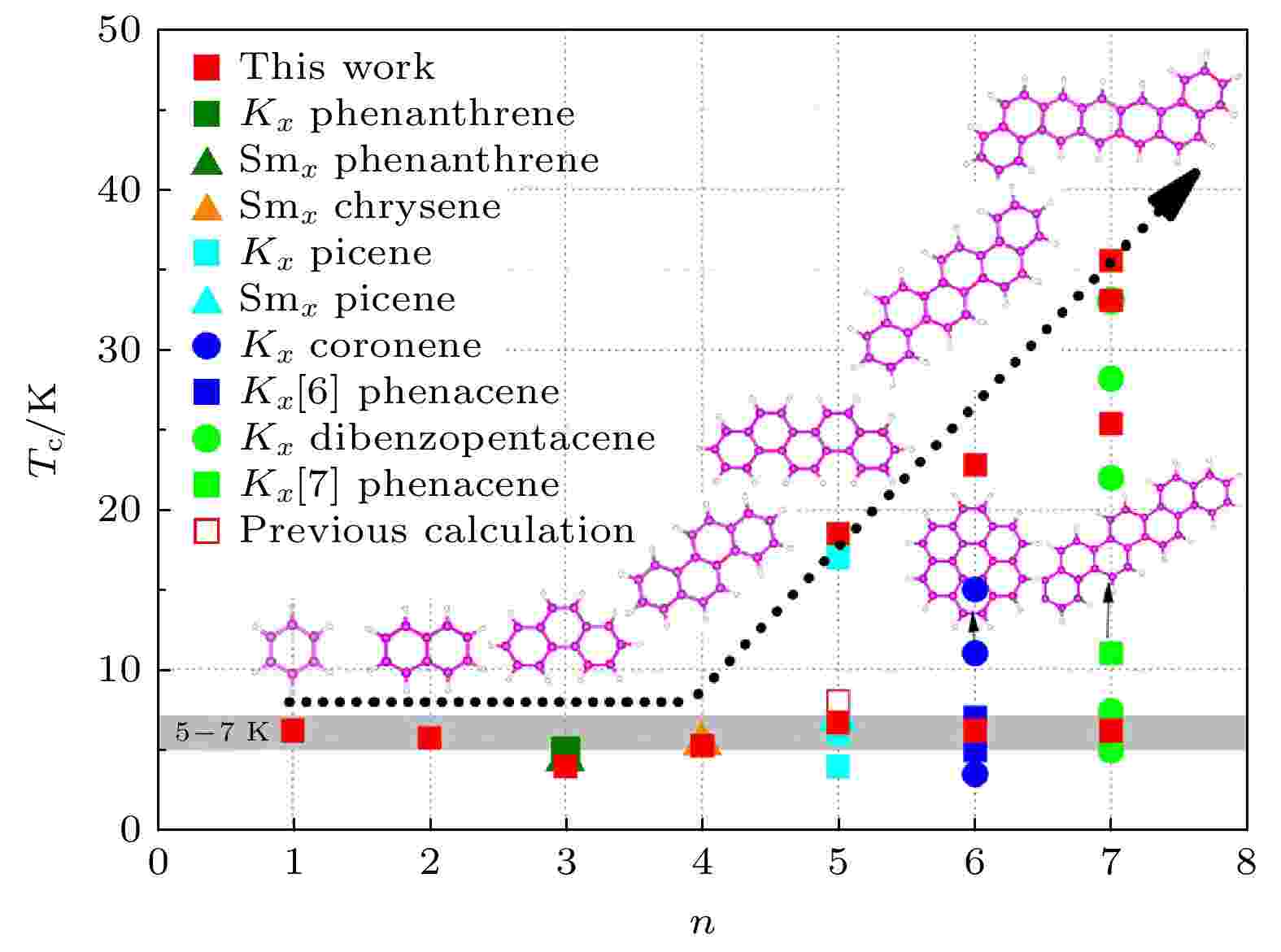
EDITOR'S SUGGESTION
2023, 72 (23): 237403.
doi:10.7498/aps.72.20231751
Abstract +
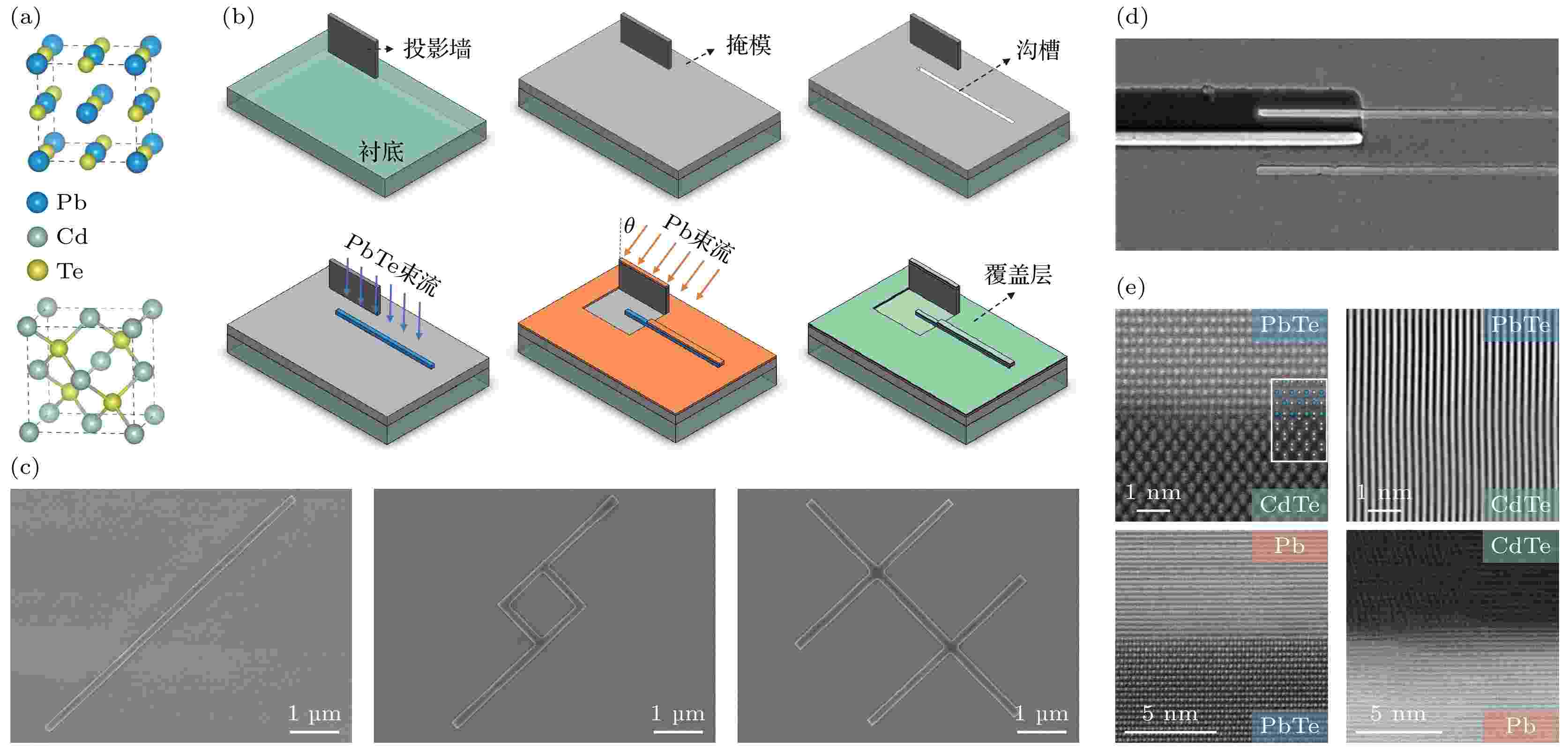
EDITOR'S SUGGESTION
2023, 72 (23): 238101.
doi:10.7498/aps.72.20231603
Abstract +
Semiconductor-superconductor hybrid nanowire is one of the major platforms for realizing Majorana zero modes (MZMs) and topological quantum computing (TQC), and the III-V InAs and InSb-based nanowires are the most-studied materials in this approach. Despite years of efforts to improve and optimize materials, too many defects and impurities in the nanowire samples remain the central problem hindering the research progress in this direction. In recent years, a new candidate Majorana nanowire system—IV-VI semiconductor PbTe-superconductor hybrid nanowire—has attracted much attention and witnessed rapid research progress. The unique advantages of PbTe-based nanowires, such as the large dielectric constant and the presence of a lattice-matched substrate, give them great potential in solving the bottleneck problem of sample defects and impurities, making them an ideal platform for studying MZMs and TQC. In this paper, we briefly introduce the recent research progress of selective area growth and transport characterization of in-plane PbTe nanowires and PbTe-superconductor hybrid nanowires. We also discuss the advantages and problems of the new candidate Majorana nanowire system as well as the prospect of realizing TQC based on it.

EDITOR'S SUGGESTION
2023, 72 (23): 230301.
doi:10.7498/aps.72.20231152
Abstract +
The fundamental concepts of phases of matter and thermal phase transitions constitute the cornerstone of our understanding of the physical universe. The historical development of the phase transition theory from Landau’s spontaneous symmetry breaking paradigm to modern topological phase transition theories represents a major milestone in the evolution of numerous scientific disciplines. From the perspective of emergent philosophy, the interplay of topological excitations leads to enriched physical phenomena. One prominent prototype is the Berezinskii-Kosterlitz-Thouless (BKT) phase transition, where unbinding of integer vortices occurs in the absence of spontaneous breaking of continuousU(1) symmetry. Using the state-of-the-art tensor network methods, we express the partition function of the two-dimensionalXY-related system in terms of a product of one-dimensional transfer operators. From the singularities of the entanglement entropy of the one-dimensional transfer operator, we accurately determine the complete phase diagram of the partition function. This method provides new insights into the emergent phenomenon driven by topological excitations, and sheds new light on future studies of 2D systems with continuous symmetries.
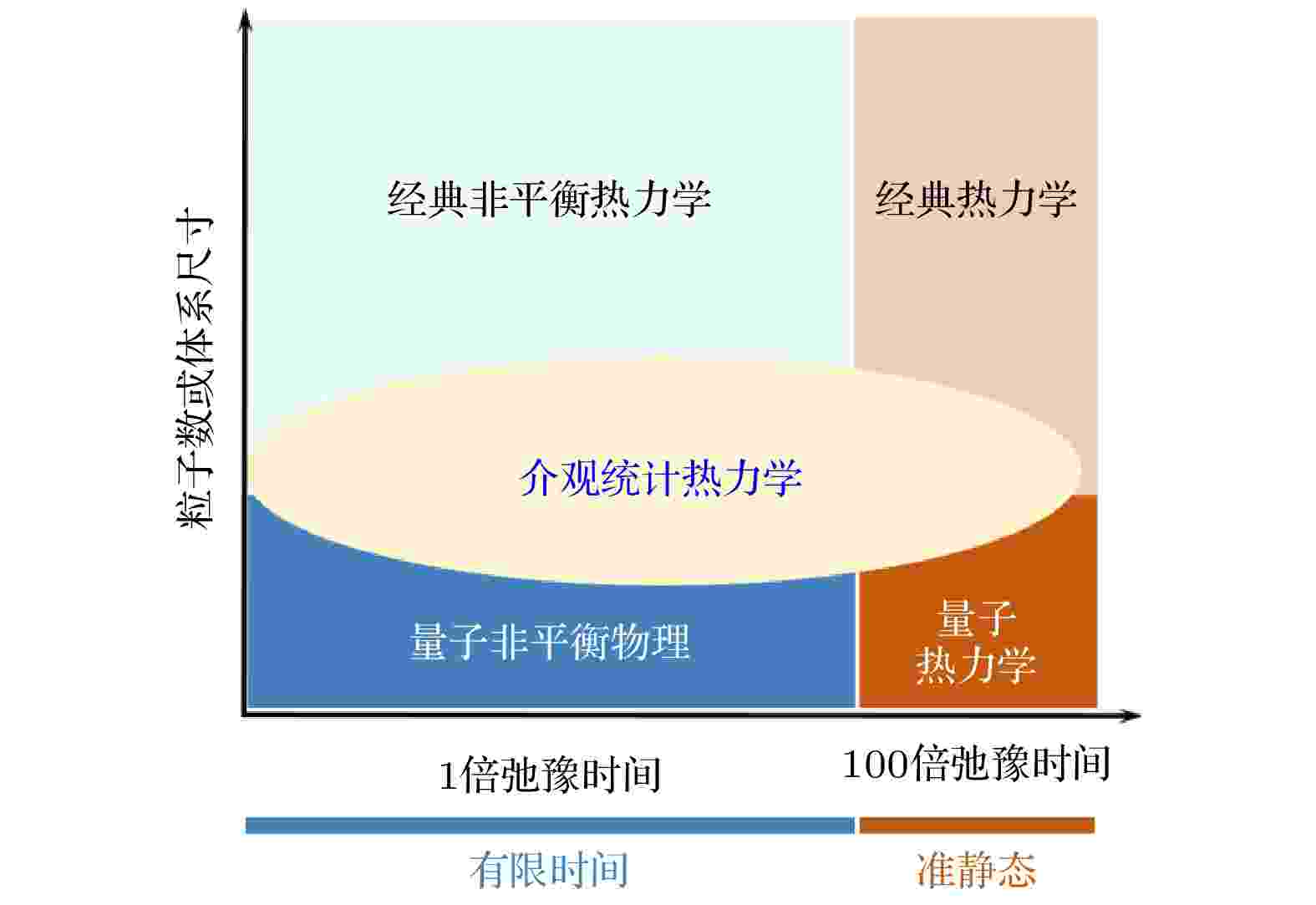
EDITOR'S SUGGESTION
2023, 72 (23): 230501.
doi:10.7498/aps.72.20231608
Abstract +
Does thermodynamics still hold true for mecroscopic small systems with only limited degrees of freedom? Do concepts such as temperature, entropy, work done, heat transfer, isothermal processes, and the Carnot cycle remain valid? Does the thermodynamic theory for small systems need modifying or supplementing compared with traditional thermodynamics applicable to macroscopic systems? Taking a single-particle system for example, we investigate the applicability of thermodynamic concepts and laws in small systems. We have found that thermodynamic laws still hold true in small systems at an ensemble-averaged level. After considering the information erasure of the Maxwell’s demon, the second law of thermodynamics is not violated. Additionally, ‘small systems’ bring some new features. Fluctuations in thermodynamic quantities become prominent. In any process far from equilibrium, the distribution functions of thermodynamic quantities satisfy certain rigorously established identities. These identities are known as fluctuation theorems. The second law of thermodynamics can be derived from them. Therefore, fluctuation theorems can be considered an upgradation to the second law of thermodynamics. They enable physicists to obtain equilibrium properties (e.g. free energy difference) by measuring physical quantities associated with non-equilibrium processes (e.g. work distributions). Furthermore, despite some distinct quantum features, the performance of quantum heat engine does not outperform that of classical heat engine. The introduction of motion equations into small system makes the relationship between thermodynamics and mechanics closer than before. Physicists can study energy dissipation in non-equilibrium process and optimize the power and efficiency of heat engine from the first principle. These findings enrich the content of thermodynamic theory and provide new ideas for establishing a general framework for non-equilibrium thermodynamics.
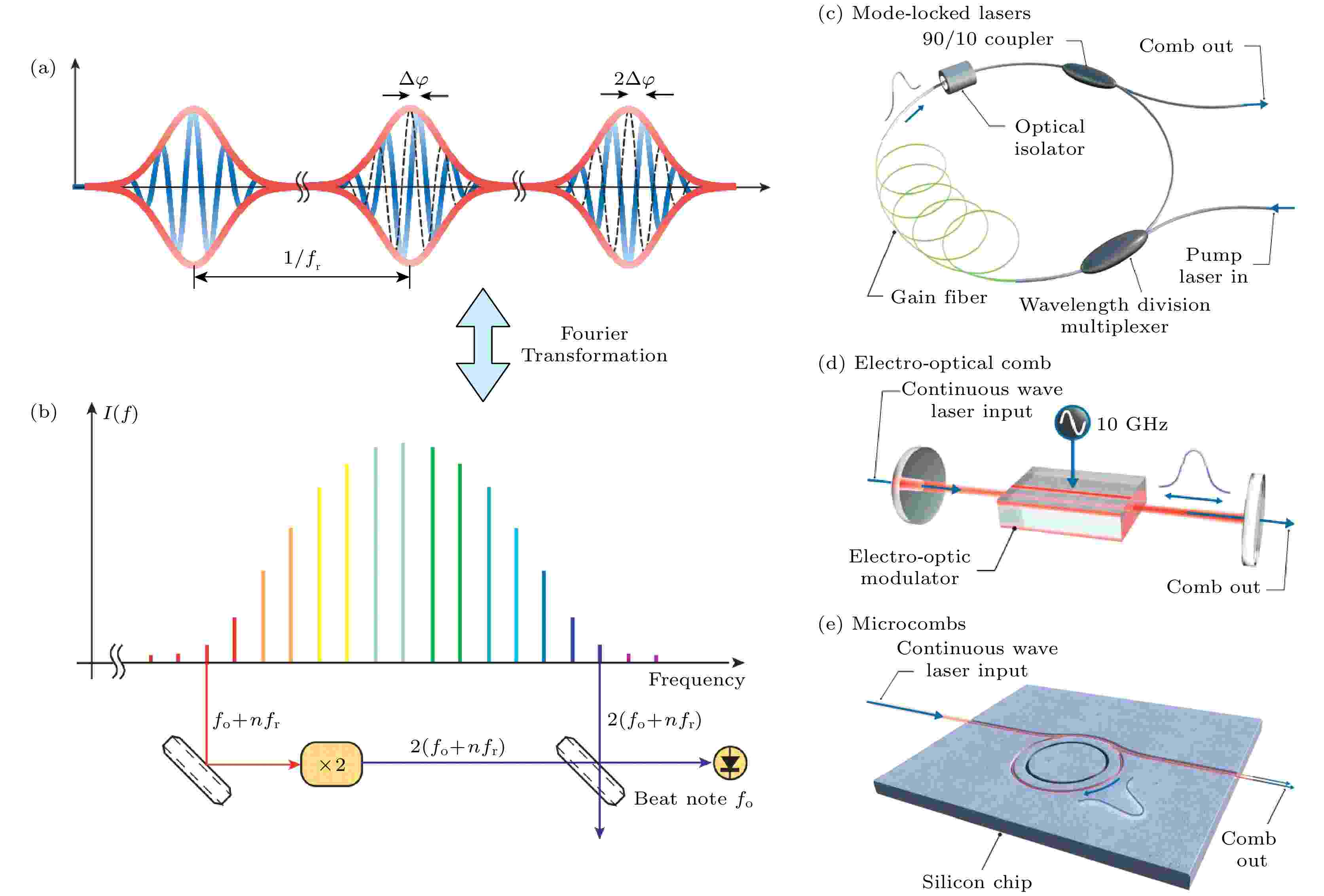
EDITOR'S SUGGESTION
2023, 72 (23): 234203.
doi:10.7498/aps.72.20231816
Abstract +
Optical frequency comb (OFC) has coherently bridged the gap between light and microwave. Its advent has brought revolutionary progress to the accurate measurements of optical frequency and time, and profoundly promoted the technological development of technology of the contemporary world. The earliest optical frequency combs are generated from mode-locked laser systems. However, optical frequency combs based on mode-locked lasers have typically been limited to laboratory applications, due to their complexity, large size, and high cost. In recent years, a new type of optical frequency comb has emerged to address these problems. It is excited by continuous-wave laser coupling into a high-quality optical microresonator, generating equidistant sidebands in the frequency domain through four-wave mixing, and achieving mode locking in the time domain by using nonlinear effects to balance dispersion. This novel optical frequency comb is named "microcombs". Compared with traditional optical frequency combs, microcombs offer advantages such as compact size, integrability, low power consumption, and a wide repetition frequency range. Their occurrence marks the era of the generation of optical frequency combs towards chip-scale size and has aroused increasing attention from the scientific and industrial communities. This paper is ended by summarizing the current challenges faced by microcombs and giving a prospective outlook on their future development.
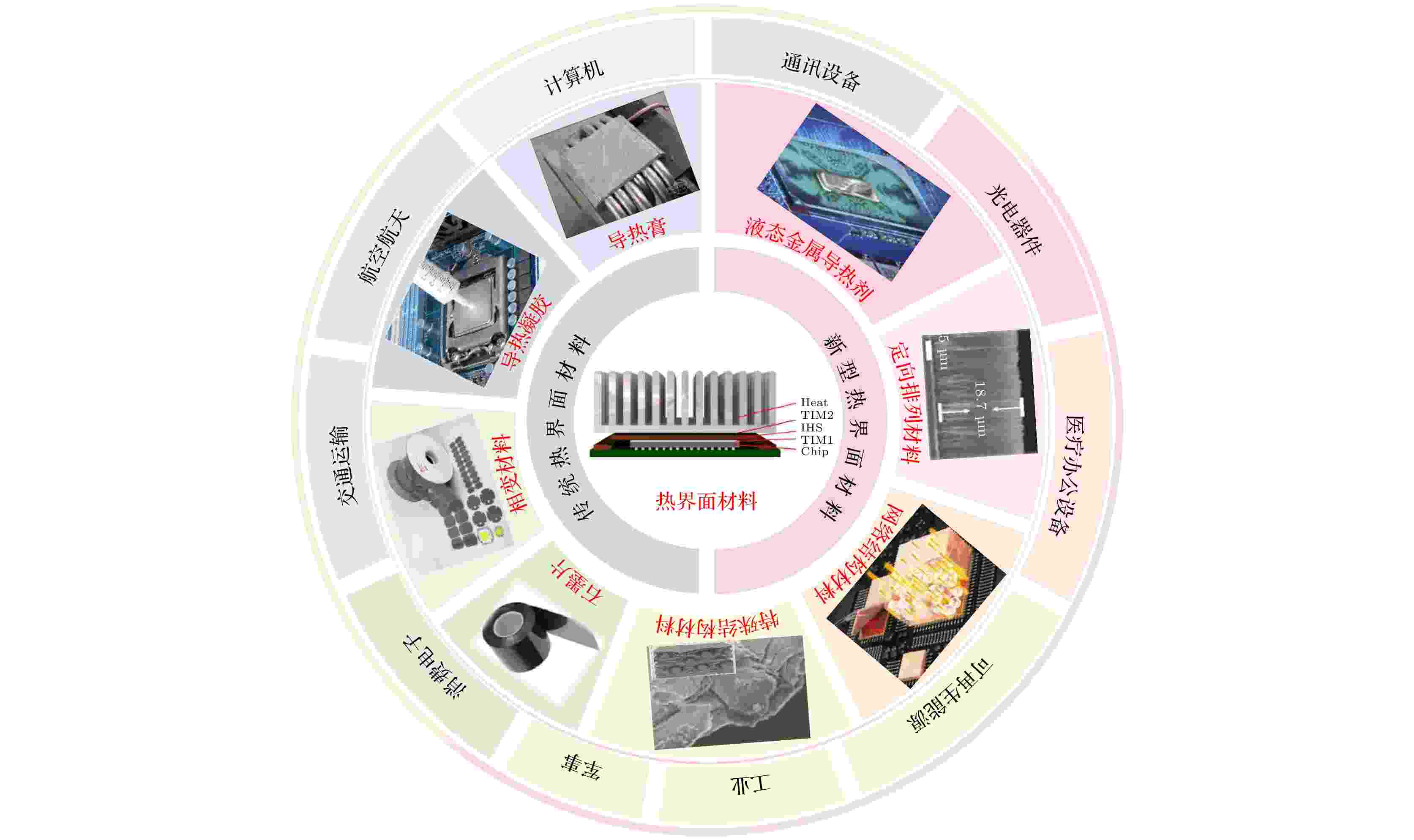
EDITOR'S SUGGESTION
2023, 72 (23): 234401.
doi:10.7498/aps.72.20231546
Abstract +
“Heat death”, namely, overheating, which will deteriorate the function of chips and eventually burn the device and has become an obstacle in the roadmap of the semiconductor industry. Therefore, heat dissipation becomes a key issue in further developing semiconductor. Heat conduction in chips encompasses the intricate dynamics of phonon conduction within one-dimensional, two-dimensional materials, as well as the intricate phonon transport through interfaces. In this paper, the research progress of the complexities of phonon transport on a nano and nanoscale in recent three years, especially the size dependent phonon thermal transport and the relationship between anomalous heat conduction and anomalous diffusion are summarized. Further discussed in this paper is the fundamental question within non-equilibrium statistical physics, particularly the necessary and sufficient condition for a given Hamiltonian whose macroscopic transport behavior obeys Fourier’s law. On the other hand, the methods of engineering the thermal conduction, encompassing nanophononic crystals, nanometamaterials, interfacial phenomena, and phonon condensation are also introduced. In order to comprehensively understand the phononic thermal conduction, a succinct overview of phonon heat transport phenomena, spanning from thermal quantization and the phonon Hall effect to the chiral phonons and their intricate interactions with other carriers is presented. Finally, the challenges and opportunities, and the potential application of phonons in quantum information are also discussed.
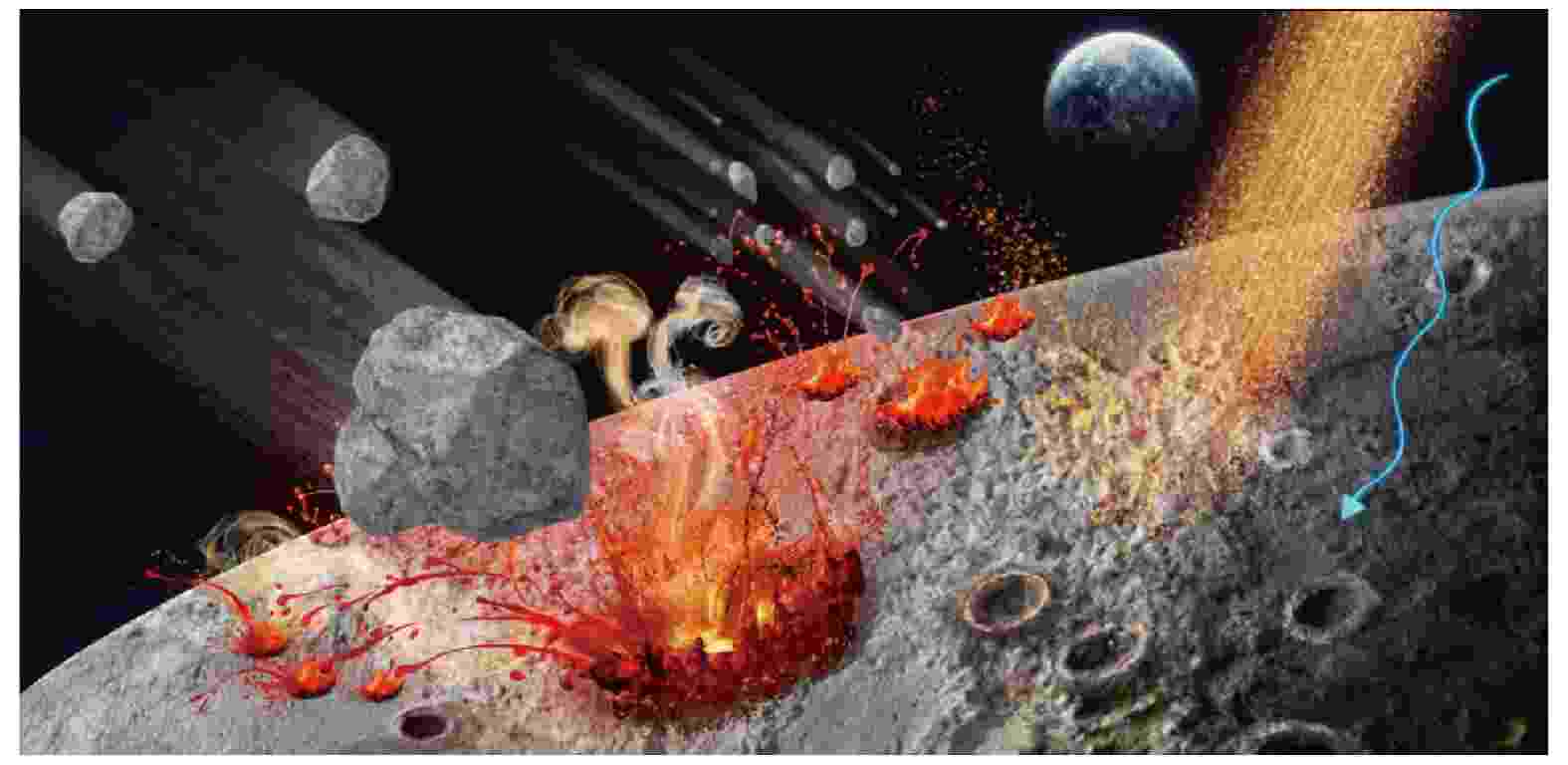
EDITOR'S SUGGESTION
2023, 72 (23): 236101.
doi:10.7498/aps.72.20231238
Abstract +
Lunar glass, a significant component of lunar soil, is produced by non-equilibrium processes on the moon, such as volcanic eruptions, meteorite impacts, solar wind, and cosmic radiation. Lunar glass of different origins has ability to record historical information of the formation and evolution of the moon. This article presents a comprehensive review of the research progress of lunar glasses found within the CE-5 lunar soil. Delving into their fundamental physical properties and microstructure, we explore the specific mechanisms behind the formation of lunar glasses. Furthermore, this article focuses on the various roles that lunar glasses play in studies of lunar evolution, such as acting as a “natural camera” that captures the moon's internal and surface changes over different epochs, encompassing lunar origin, magma activity, impact events, space weathering, and the origin of water. The ultra-stable lunar glass with disordered atomic structure can sustainably preserve lunar resources. It is estimated that lunar glasses have reserved approximately 260000 tons of3He, and 27 billion tons of water. Moreover, lunar glasses serve as an invaluable lunar chronometer, providing a reliable temporal framework to data volcanic activity and impact events. This temporal framework, in turn, serves as a vital tool for investigating the evolution of lunar water, magnetic fields and reconstructing the extensive billion-year history of lunar impacts.
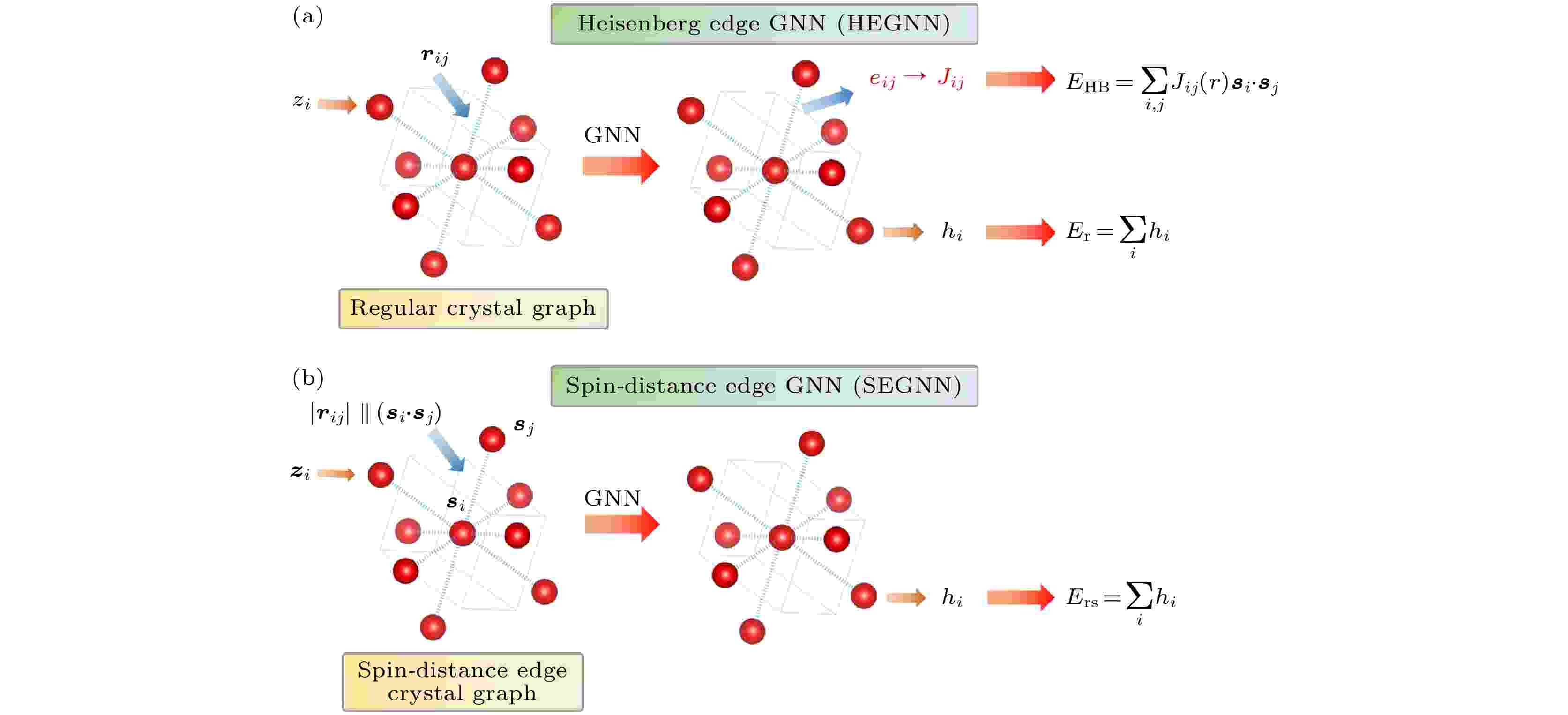
EDITOR'S SUGGESTION
2023, 72 (23): 237102.
doi:10.7498/aps.72.20231313
Abstract +
The influence of electromagnetic field on material characteristics remains a pivotal concern in scientific researches. Nonetheless, in the realm of computational condensed matter physics, the extension of traditional density functional theory to scenarios inclusive of external electromagentic fields poses considerable challenges. These issues largely stem from the disruption of translational symmetry by external fields inherent in periodic systems, rendering Bloch's theorem inoperative. Consequently, the using the first-principles method to calculate material properties in the presence of external fields becomes an intricate task, especially in circumstances where the external field cannot be approximated as a minor perturbation. Over the past two decades, a significant number of scholars within the field of computational condensed matter physics have dedicated their efforts to the formulation and refinement of first-principles computational method adopted in handling periodic systems subjected to finite external fields. This work attempts to systematically summarize these theoretical methods and their applications in the broad spectrum, including but not limited to ferroelectric, piezoelectric, ferromagnetic, and multiferroic domains. In the first part of this paper, we provide a succinct exposition of modern theory of polarization and delineate the process of constructing two computation methods in finite electric fields predicated by this theory in conjunction with density functional theory. The succeeding segment focuses on the integration of external magnetic fields into density functional theory and examining the accompanying computational procedures alongside the challenges they present. In the third part, we firstly review the first-principles effective Hamiltonian method, which is widely used in the study of magnetic, ferroelectric and multiferroic systems, and its adaptability to the case involving external fields. Finally, we discuss the exciting developments of constructing effective Hamiltonian models by using machine learning neural network methods , and their extensions according to the external fields.
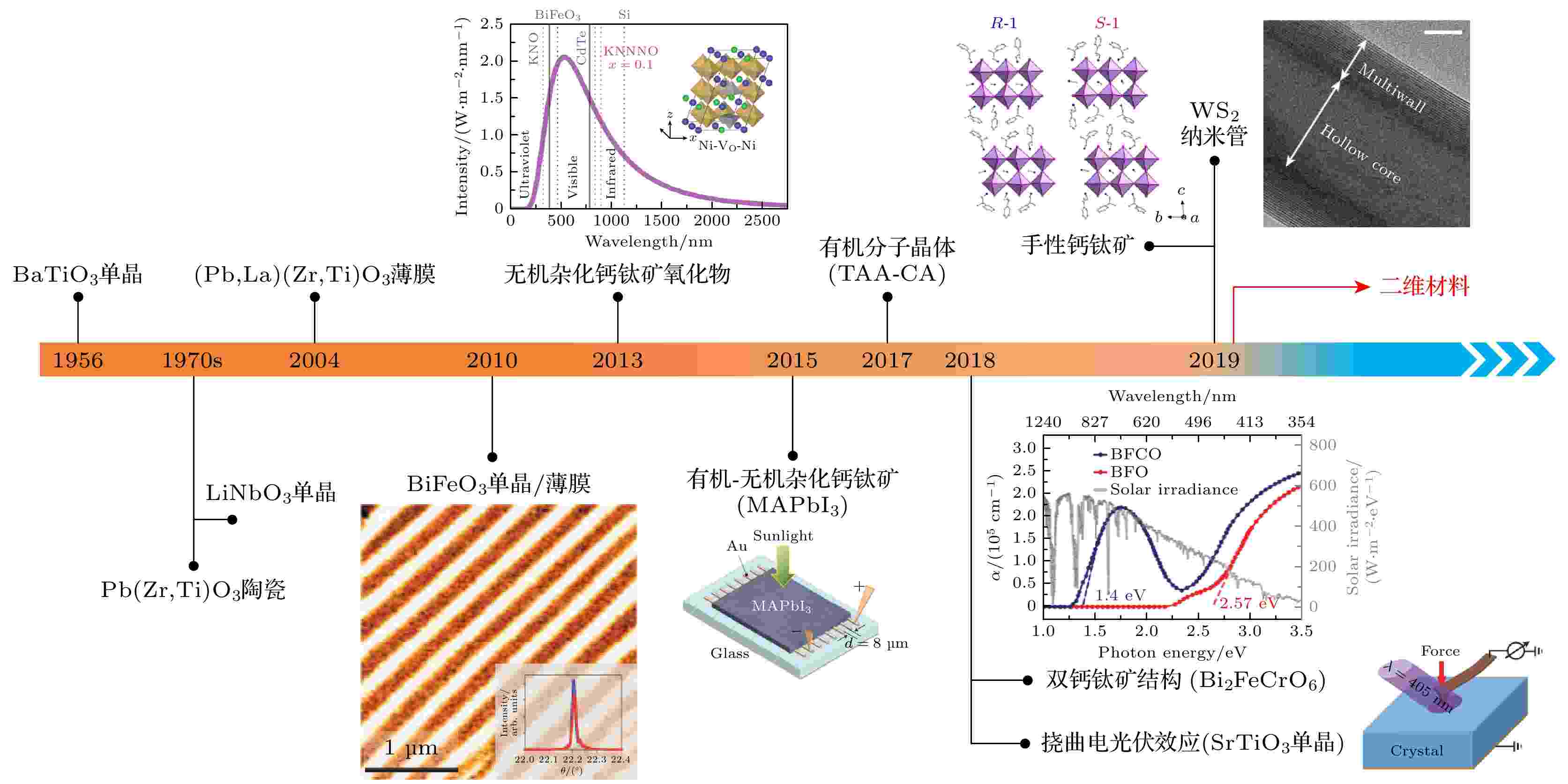
EDITOR'S SUGGESTION
2023, 72 (23): 237201.
doi:10.7498/aps.72.20231786
Abstract +
The bulk photovoltaic effect is a second-order nonlinear photoelectric response, which refers to a phenomenon that non-centrosymmetric structural material generates a steady-state photocurrent under uniform light irradiation. The bulk photovoltaic effect has attracted widespread attention due to its open-circuit voltage is not limited by the semiconductor bandgap and power conversion efficiency breaks through the Shockley-Queisser limit. In addition, the bulk photovoltaic effect is closely related to the quantum geometric properties (such as Berry curvature and quantum metric) of solids, thus making it an effective means to study crystal polarization, orbital magnetization, and quantum Hall effects. Two-dimensional (2D) materials are rich in electrical, optical, magnetic, topological properties and their interactions, which can effectively improve the performances of bulk photovoltaic devices (such as expanding response range of bulk photovoltaic effect) and have important research value for exploring basic physical problems. This paper reviews the development process of bulk photovoltaic effect and its physical mechanism. The research progress of bulk photovoltaic effect in 2D materials is discussed in detail, including single component 2D materials, 2D material stacking engineering (such as 2D material homojunctions and heterojunctions), and other factors (such as magnetic field, strain engineering) to generate or regulate the bulk photovoltaic effect response. Finally, the development prospect of two-dimensional bulk photovoltaic effect is prospected.
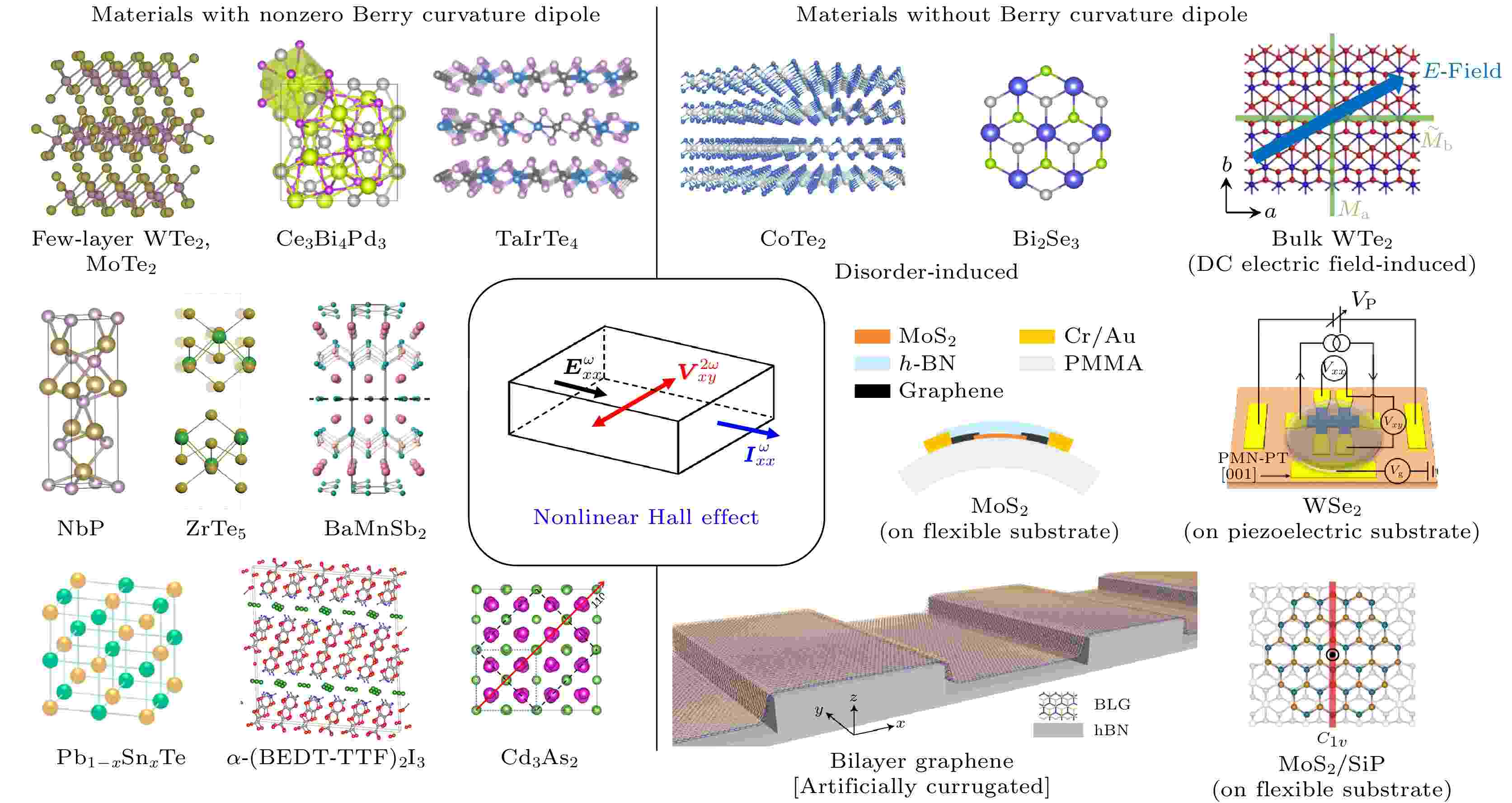
EDITOR'S SUGGESTION
2023, 72 (23): 237301.
doi:10.7498/aps.72.20231324
Abstract +
The Hall effect refers to the generation of a voltage in a direction perpendicular to the applied current. Since its discovery in 1879, the Hall effect family has become a huge group, and its in-depth study is an important topic in the field of condensed matter physics. The newly discovered nonlinear Hall effect is a new member of Hall effects. Unlike most of previous Hall effects, the nonlinear Hall effect does not need to break the time-reversal symmetry of the system but requires the spatial inversion asymmetry. Since 2015, the nonlinear Hall effect has been predicted and observed in several kinds of materials with a nonuniform distribution of the Berry curvature of energy bands. Experimentally, when a longitudinal alternating current (AC) electric field is applied, a transverse Hall voltage will be generated, with its amplitude proportional to the square of the driving current. Such a nonlinear Hall signal contains two components: one is an AC transverse voltage oscillating at twice the frequency of the driving current, and the other is a direct current (DC) signal converted from the injected current. Although the history of the nonlinear Hall effect is only a few years, its broad application prospects in fields of wireless communication, energy harvesting, and infrared detectors have been widely recognized. The main reason is that the frequency doubling and rectification of electrical signals via some nonlinear Hall effects are achieved by an inherent quantum property of the material - the Berry curvature dipole moment, and therefore do not have the thermal voltage thresholds and/or the transition time characteristic of semiconductor junctions/diodes. Unfortunately, the existence of the Berry curvature dipole moment has more stringent requirements for the lattice symmetry breaking of the system apart from the spatial inversion breaking, and the materials available are largely limited. This greatly reduces the chance to optimize the signal of the nonlinear Hall effect and limits the application and development of the nonlinear Hall effect. The rapid development of van der Waals stacking technology in recent years provides a brand new way to design, tailor and control the symmetry of lattice, and to prepare artificial moiré crystals with certain physical properties. Recently, both theoretical results and experimental studies on graphene superlattices and transition metal dichalcogenide superlattices have shown that artificial moiré superlattice materials can have larger Berry curvature dipole moments than those in natural non-moiré crystals, which has obvious advantages in generating and manipulating the nonlinear Hall effect. On the other hand, abundant strong correlation effects have been observed in two-dimensional superlattices. The study of the nonlinear Hall effect in two-dimensional moiré superlattices can not only give people a new understanding of the momentum space distribution of Berry curvatures, contributing to the realization of more stable topological transport, correlation insulating states and superfluidity states, but also expand the functional space of moiré superlattice materials which are promising for the design of new electronic and optoelectronic devices. This review paper firstly introduces the birth and development of the nonlinear Hall effect and discusses two mechanisms of the nonlinear Hall effect: the Berry curvature dipole moment and the disorder. Subsequently, this paper summaries some properties of two-dimensional moiré superlattices which are essential in realizing the nonlinear Hall effect: considerable Berry curvatures, symmetry breaking effects, strong correlation effects and tunable band structures. Next, this paper reviews theoretical and experimental progress of nonlinear Hall effects in graphene and transition metal dichalcogenides superlattices. Finally, the future research directions and potential applications of the nonlinear Hall effect based on moiré superlattice materials are prospected.
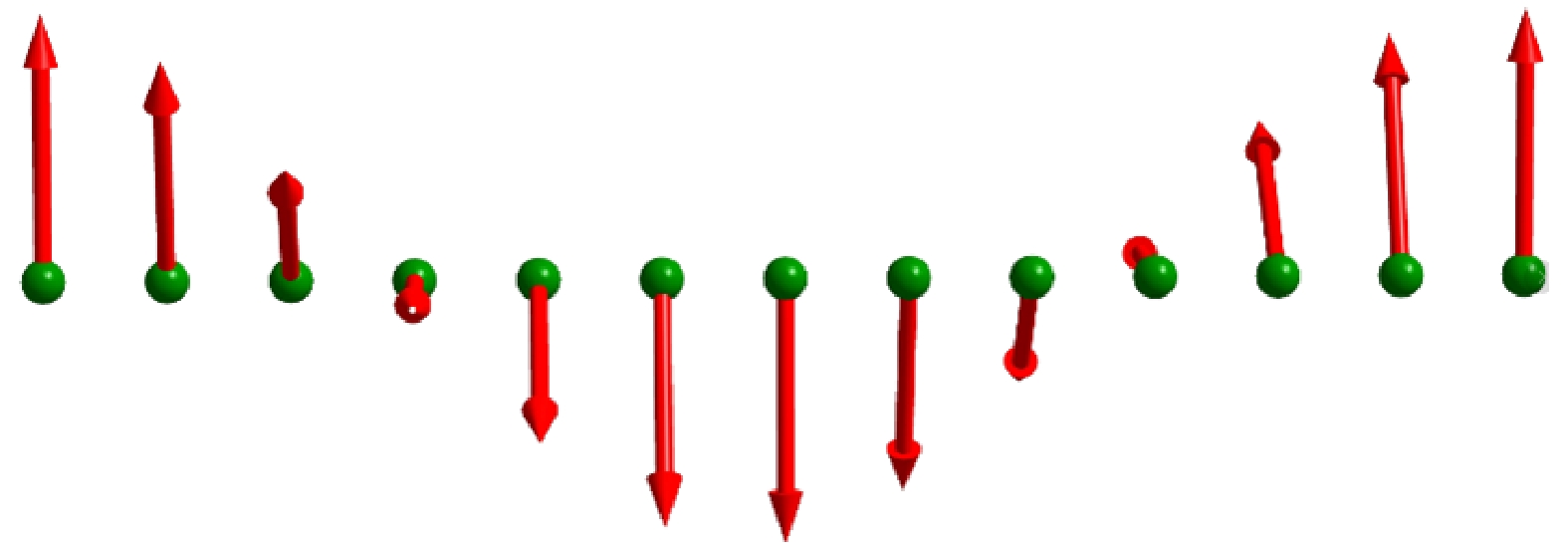
EDITOR'S SUGGESTION
2023, 72 (23): 237501.
doi:10.7498/aps.72.20231118
Abstract +
As a common phenomenon in nature, phase transition has received much attention for a long time. It has been applied to various fields, such as refrigeration, information and energy storage, and negative thermal expansion. Solid refrigeration technology based on magnetocaloric effect, electrocaloric effect, and mechanocaloric effect has the advantages of environmental protection, high efficiency, no noise, and easy miniaturization, and is expected to replace vapor compression technology. Among them, the magnetocaloric effect has the longest research history. However, the shortcomings of magnetocaloric effect driven by a single magnetic field limit its solid-state refrigeration application, such as insufficient amplitude of caloric effect, large hysteresis loss, and narrow refrigeration temperature span. To solve these problems, multifield tuning and multicaloric effect have come into people's sight. This paper introduces our recent research on improving the caloric effect by applying multifield, such as increasing entropy change, expanding transition temperature range, adjusting transition temperature, and reducing hysteresis losses. The thermodynamics of multifield and coupled-caloric effect are presented in the meantime. On the other hand, materials with abnormal thermal expansion (zero thermal expansion, negative thermal expansion) have important applications in precision manufacturing. The phase transition and lattice effect dominated by magnetic atoms in the giant magnetocaloric materials with strong magnetic-crystal coupling provide an ideal platform for exploring abnormal thermal expansion. This paper also introduces our recent research on abnormal thermal expansion in magnetocaloric materials, and looks forward to future relevant research.
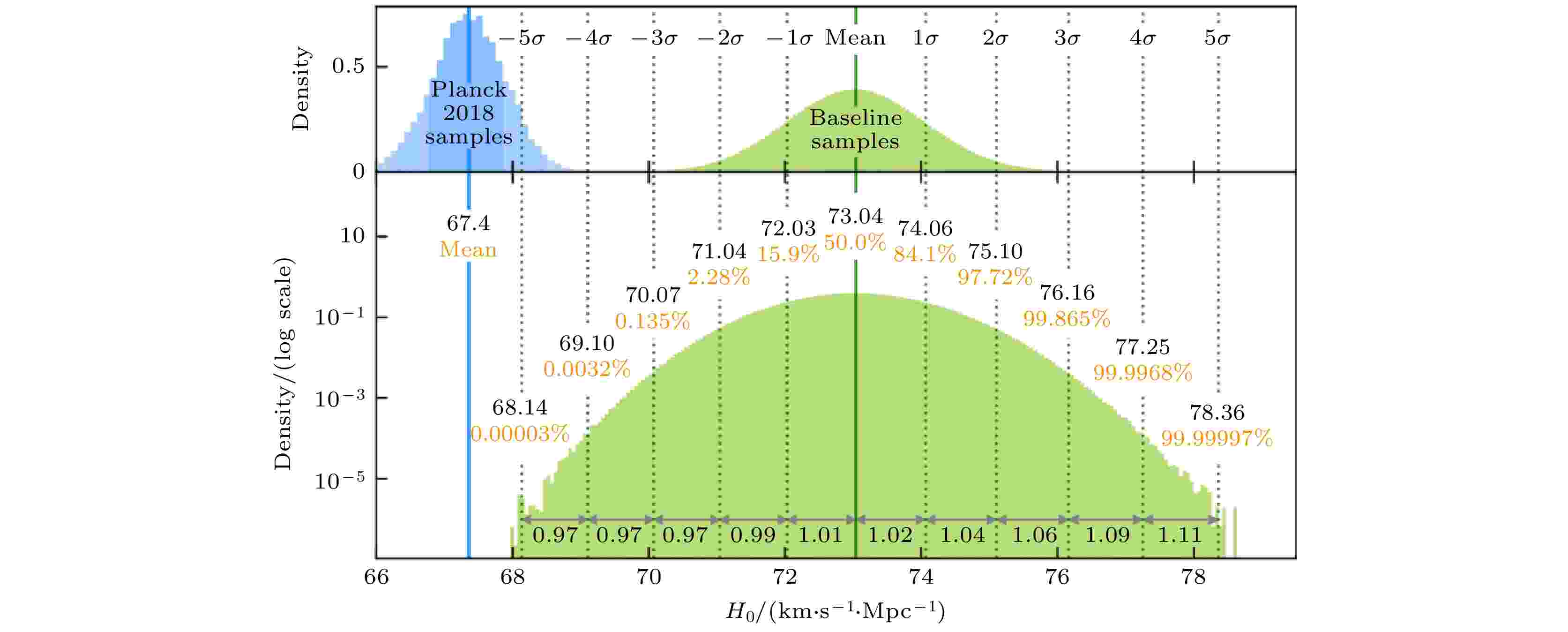
EDITOR'S SUGGESTION
2023, 72 (23): 239801.
doi:10.7498/aps.72.20231270
Abstract +
The Hubble constant quantitatively characterizes the expansion rate of the current Universe, and its precise measurement has become a crucial scientific problem. In recent years, there has been an increasingly serious discrepancy between the local direct measurements of the Hubble constant and the global fitting results, where the local direct measurements come from the local distance ladder measurements of the late universe, and the global fitting results come from fitting the standard model of cosmology to the microwave background radiation from the early universe. If this discrepancy is not caused by the observation error and systematic error of any of the observation methods, it probably means that there is a new physics beyond the existing standard model of cosmology. This article briefly reviews the Hubble constant problem from two aspects with observational and theoretical points of view, and finally provide a perspective view from both observational and theoretical aspects by combining the author’s research on this problem in recent years. The observational review includes cosmological observations from both early Universe (either depending or independent of the CMB measurements) and late Universe (either depending or independent of the distant-ladder measurements), and the theoretical review includes model buildings from modifying both early Universe (either recombination history or expansion history) and late Universe (either homogeneous modifications or inhomogeneous modifications). The final observational perspective includes both local and non-local cosmic variances with their Hubble residual correlated to the matter density contrasts of observer and sample, respectively, and the final theoretical perspective concludes the interacting dark energy model as the most promising candidate for both Hubble tension andS8tension, which can be specifically realized in a chameleon dark energy model, pointing to a scale-dependent effective cosmological constant.








